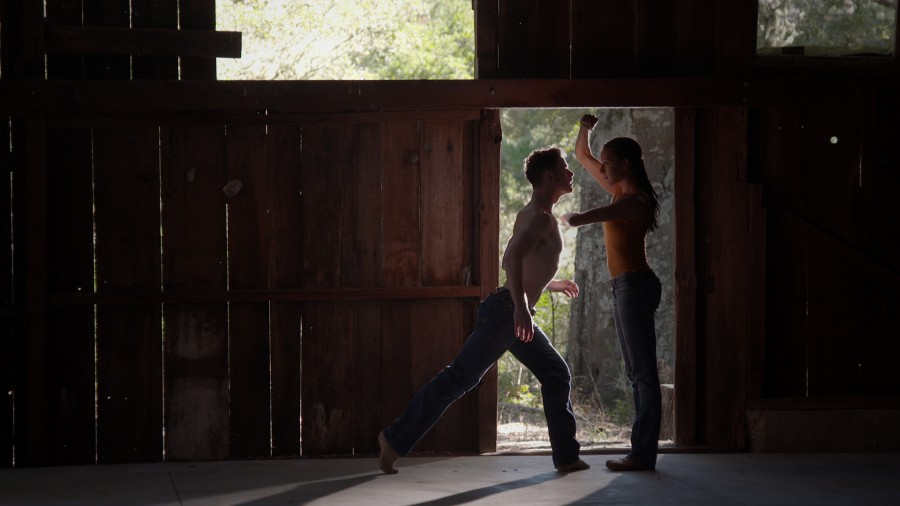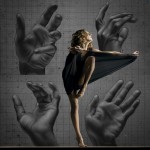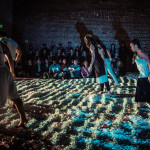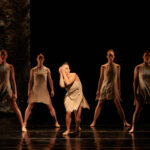A very grumpy Ballet To The People turned up late to the closing night of the San Francisco Dance Film Festival, having crawled into town from Oakland Airport at approximately 2 miles per hour over the new Eastern Span of the Bay Bridge. At a price tag of $6.4 billion, this splendid, soaring piece of architecture, designed to make an important visual statement, has so far failed to impress drivers with its primary mission, that of getting dance writers to performances on time.
Within minutes, however, Ballet To The People’s customary radiant smile reappeared, thanks to inspired programming by the wizards at SFDFF, who juxtaposed two finely crafted festival entries with the results of an experiment that paired three Bay Area choreographers with three filmmakers and gave them one week to come up with a finished product.
The Co-Laboratory Project – brainchild of festival Managing Director Judy Flannery – took place at the Djerassi Ranch, an artists’ retreat in the idyllic town of Woodside, south of San Francisco. The three choreographers work in different idioms – Amy Seiwert in modern ballet, Yaelisa in flamenco, KT Nelson in contemporary dance – and each chose to use the site in a different manner. Seiwert placed her couple in an old barn; Nelson had three dancers racing through woods and open fields; Yaelisa opened with an encounter in the woods between a young girl and a woman, followed by a flamenco performance filmed in a studio.
The single most striking difference between the three films was not the type of dance involved, but the handling of light.
Seiwert and her filmmakers Kristine Samuelson and John Haptas made the most dramatic use of light. In their Barn Dance, light streamed through a partially open barn door, and filtered through skylights and cracks in wall boards, creating spotlights on the smooth concrete floor. The natural barn lighting was enhanced by gaffer Eric Blum, but the effect was still organic.
In keeping with the barn setting, dancers Sarah Griffin and Wes Krukow were simply dressed in jeans, with no trace of make-up. Seiwert’s trademark sleek partnering is similarly without artifice, tender yet powerful. The outward simplicity, reinforced by the moody, atmospheric score by Darren Johnston, belied the sophistication and complexity of the choreography, lighting, filming and editing. The camera angle, height and framing varied dramatically, adding movement to movement; at times the camera appeared to be a third partner in this intimate dance.
The final sequence was shot from a distance outside the barn, at twilight, so that all we could see were the hazy silhouettes of the dancers as they criss-crossed in front of a lighted window. The camera – which had initially brought us so close to the dancers that we could see the pores on their skin, the scuff marks on her pointe shoes – turned us into voyeurs at the end, straining our eyes to catch a glimpse of the lovers.
KT Nelson’s disarming From the Beginning did away with a score altogether, replacing it with the dancers’ breathing and calling out instructions to each other as they attempted to make the dance ‘work’ (“maybe if I put my foot here,” “hold me there,” “let me take my socks off”). We heard the voices and the rapid breathing before the dancers appeared on camera – which drew chuckles from the audience at the sexual double entendres.
Vanessa Thiessen, Justin Andrews, and Scott Marlowe (and cinematographer Daniel Marks), attired in sneakers and casual wear, chased each other gleefully through the woods, like carefree children on a summer holiday, then tackled each other in several rough-and-tumble pas de deux – male/female then male/male – and a final ménage a trois.

Vanessa Thiessen, Justin Andrews, and Scott Marlowe in KT Nelson’s FROM THE BEGINNING (Photo courtesy SFDFF)
Maybe there was a story here, maybe there wasn’t; fascinating nonetheless was the exposing of the nuts and bolts – the effort – of making dance. The process is not all smooth and pretty, but fundamentally trial-and-error, rife with awkward stops, starts and stumbles, requiring periodic fine-tuning – a dance has to be engineered, just like that damn Eastern Span – then suddenly you get one or two moments of sheer beauty and magic, and you see the dancers’ eyes light up.
The film by Chris Mason Johnson, which was shot entirely in natural light, though bounced and redirected in a multitude of ways by the resourceful Jon Boal, celebrates the wild beauty of Djerassi Ranch as much as it does the athleticism and poetry of the dancers’ bodies.
In the Blood, Yaelisa’s tribute to her mother, flamenco singer-dancer Isa Mura, was filmed by John Korty and featured guitarist Jason McGuire and singer José Cortes. The camera movement was more stately, less acrobatic than the other two co-lab films, panning back and forth between the dancer and each musician, never framing them together. The studio lighting was bright, almost harsh, with illuminating close-ups of feet and hands. This view of flamenco was different than that to which we’ve been accustomed, more often than not lit by the sparest of spotlights and plumes of cigarette smoke.
The decision to frame each performer individually seemed, at first, to undercut the intense three-way communication so central to flamenco. But being forced to focus on only one artist at a time turned out to be a gift, as McGuire, Cortes and Yaelisa are virtuosos of the highest order, forceful and mesmerizing.
The touching opening scene between Yaelisa and the young Naima Camargo, who come together in the woods, is filmed in a grainy black-and-white, reminding us that – unlike music, which has a robust notation system – dance has relied on memory, and the passing of tradition from teacher to student.
That is, until film came along.
Today, film serves a critical documentary purpose, but filmed dance has increasingly become a unique work of art distinct from live performance, as evidenced by Momentum and Well Contested Sites, the other two films aired on closing night. The latter – directed and shot by Austin Forbord in the ghostly cells at Alcatraz, and choreographed by Amie Dowling on a company of men that includes former prison inmates and untrained dancers – drives home a scorching message about the wages of mass incarceration. It does so with the simplest of choreography: ritualized, repetitive movement against a hypnotic score by Eli Nelson. Repetition again in the use of props, in the eloquent tracking shots of rows of cells, and cinematic techniques like overexposure, and the vivid use of color, create an otherworldly feel, at once confining and liberating.
Well Contested Sites from Rapt Productions on Vimeo.
Shot in what could pass for a prison cell, Momentum, by Boris Seewald, delivers a highly original and side-splitting take on the transformative power of dance, using the filming and editing techniques of MTV-style music videos but with far more subtlety and imagination, and an irresistible streak of lunacy. Starting with a simple but hilarious premise involving a tortilla chip, the film celebrates the magnetic Patrick Hanna, a young dancer with a mischievous twinkle in his eye, who entices his middle-aged mother, played by Shoko Ito, into his surreal dance world.
Momentum added two more awards (best student film; best screendance up to 15 minutes) to its growing stockpile. The closing festivities included an awards ceremony hosted by the irreverent Michael Nunn and his more decorous colleague Billy Trevitt, both of the famed Ballet Boyz from London. The Six Seasons, Gilles Delamas’ moving account of Akram Khan’s exploration of his Bangladeshi roots, that culminated in the creation of his renowned solo, DESH, romped off with the best film and best documentary awards. Nunn and Trevitt, together with Ellen Bromberg, Lynette Kessler, and Muriel Maffre, served as the competition jury – though, from the quality of the entries, it appears that the festival generated quite a buzz, even without the adrenaline of competition.
This year’s ground-breaking partnership between SFDFF and Vienna-based IMZ – the European media arts organization which produces dance screen, one of Europe’s oldest and most prestigious competitive festivals for dance films – has brought Bay Area filmmakers together with European distributors, and European films to local audiences.
If you missed the festival entirely, do not despair: of the 70 films which made it through a pre-selection process to the competition, 21 of them have been made available for public viewing through Sept 28th at the Museum of Performance + Design.
– This review also appeared in the Huffington Post. –









